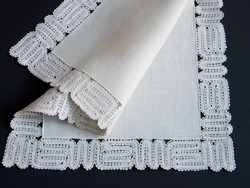Editorial board
Eugen Jurek and Ema Marková established The Society for the improvement of domestic production in Slovakia in 1939. Ema Marková later became the secretary of the organisation. The objective of the society was to represent the interests of folk production.
The society was in charge of lace production in seven state lace making workshops in the central Slovakia. It was the responsibility of the society to organise professional guidance of workshops, to buy material, working tools, patterns, and to pay for work. Templates were used to make lace in the workshops. Ema Marková, later followed by Anna Drobová made designs of patterns which had been inspired by folk motives. No remuneration was paid to the workers in the society for their designs.
The society was responsible for the sales and promotion of lace. It was difficult to sell large amounts of lace. Therefore, production was redirected to single tablecloths and dining sets.
The society took care of state lace-making workshops and had limited space for other tasks. They sought to preserve blueprint craft techniques. The society built a blueprint workshop in Bratislava the aim of which was to make folk costumes and to integrate blueprint into the modern clothing. The society opened a woodcarving workshop in the village of Jurgov in the eastern Slovakia in 1942. When the war ended, the society started to organise the production of woven and knitted carpets in the town of Nové Zámky in the south of Slovakia and the production and sale of cornhusk baskets in the village of Nesvady in 1946 – 1947.
The society organised its first exhibition of folk production at The International Danube Fair in 1939. Starting from 1940, they attended all foreign exhibitions with their products at which The Export Institute of the Trade and Industry Chamber in Bratislava displayed Slovak products.
When established in 1945, the ÚĽUV was commissioned to gather folk art productions into cooperatives. All organisations of different type including the society were aimed to vanish. The society ceased to exist in 1953 when all the activities and materials including cotton yarns, linen, silk, yarns, folk costumes, lace and embroidery, etc. were transferred to the Centre for Folk and Art Production. Extensive collection of old artefacts and special library became the property of the ÚĽUV.
